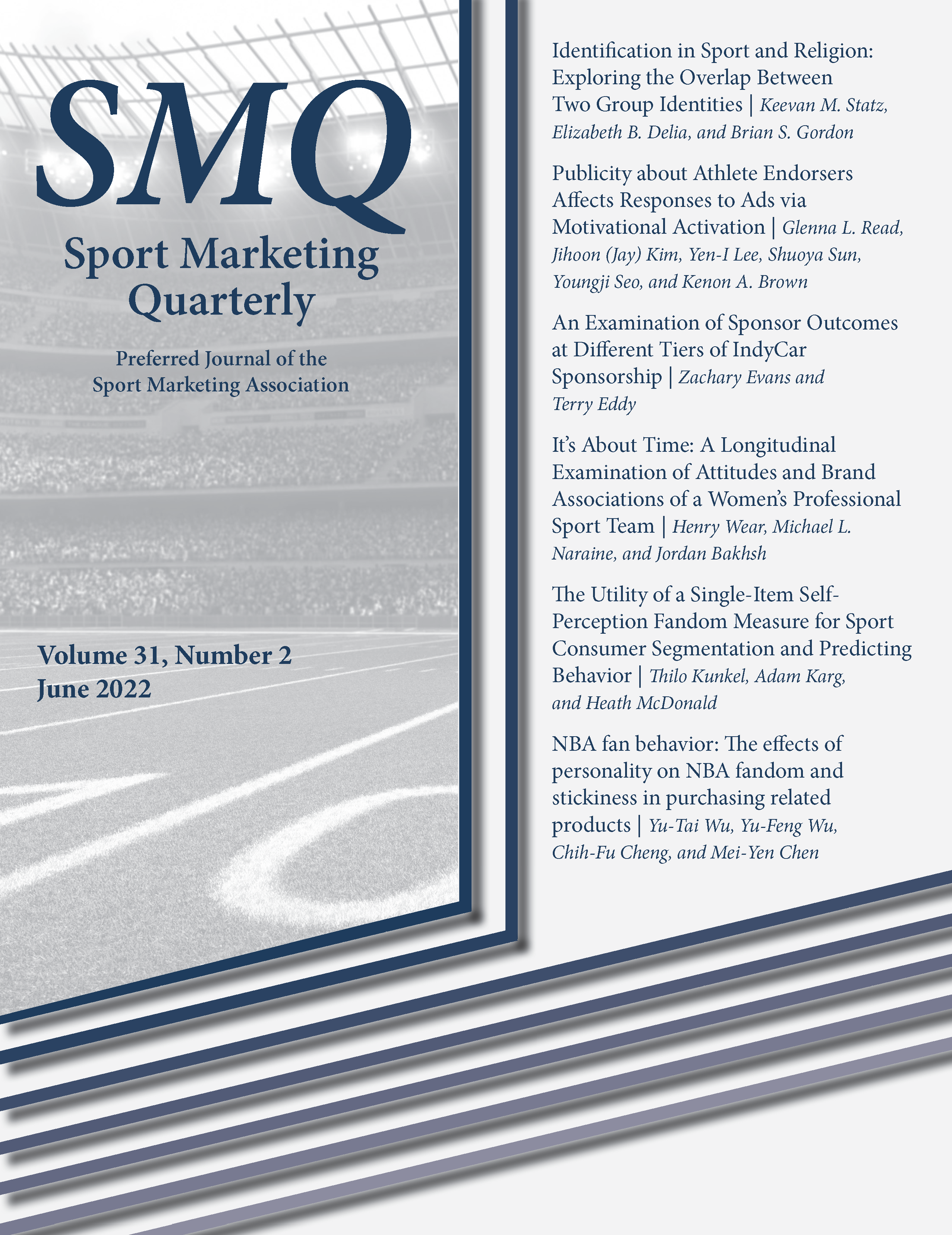Sports Marketing Quarterly
Issue 31:2 – June, 2022
Issue 31:2 – June, 2022

Keevan M. Statz, Elizabeth B. Delia and Brian S. Gordon
The potential link between sport team identity and religious identity has been recognized for decades, but minimal empirical work has examined the phenomenon. Using social identity theory and social identity complexity as a theoretical lens, this study provides both practitioners and academics with insights on the relationship between religious identification and team identification. Using a qualitative methodology, interviews were conducted with 15 individuals who highly identify with both a sport team and their religion. Among all participants, we discovered that religious identification is prioritized over team identification. Participants consistently stated that although their sport team fandom was an important part of their self-concept, religion was the most important component of who they are. Th is work expands upon the extant literature in sport management and religiosity, providing insight into the way consumers behave when considering multiple group affiliations.
Glenna L. Read, Jihoon (Jay) Kim, Yen-I Lee, Shuoya Sun, Youngji Seo and Kenon A. Brown
This research addresses how positive and negative publicity about athlete endorsers influences motivational mechanisms (appetitive and aversive) underlying cognitive and affective processing and evaluation to ads. Participants viewed an ad for a soft drink brand that featured an athlete endorser while psychophysiological measures of cognition, emotion, and arousal were collected. Each ad was preceded by a news story that contained either positive or negative information about the athlete’s off -field behavior. Results indicate that cognition and arousal were enhanced in response to ads paired with negative news stories compared to ads paired with positive news stories. Findings suggest that aversive motivational activation elicited by the negative news stories transfers to processing and evaluation of the ads.
Zachary Evans and Terry Eddy
While frequently examined in events and service research, satisfaction has received little examination in the context of sponsorship. Given the shared characteristics of both service and sport-derived products, this study, which was framed by the theory of planned behavior, aimed to examine the influence of event satisfaction, motorsport involvement, and sponsor-event fi t on both sponsor image and behavioral intentions for a title sponsor of an IndyCar event. In addition, the study explored the influence of satisfaction and motorsport involvement on sponsor awareness and image for official event sponsors. Th e results indicated that the measured constructs generally exhibited similar relationships with title and official sponsors and that there was no significant relationship between satisfaction and behavioral intention. Th us, an individual’s preconceptions of an event may be more important than their event experiences in developing behavioral intentions. Further implications for future strategy for IndyCar sponsors and event organizers are also discussed.
Henry Wear, Michael L. Naraine and Jordan Bakhsh
The proliferation and growth of women’s professional sport over time has seen a range of consumer outcomes and attention. Recently, there has been increased acknowledgement by sport marketing researchers that there is something inherently unique about the consumption and engagement of individuals as fans of women’s sport. Simultaneously, there have been new findings regarding the importance of brand associations for new sport teams as they seek to craft a brand to ensure financial success. Th is study builds on this work by showcasing the changing nature of consumer perceptions as they engage with a new women’s professional sport team. Findings indicated that attitudes related to women’s opportunity, accessibility, entertainment price, and athletic quality changed over time as individuals gained more experience with the team. Conditional growth curve modeling also provided evidence that attitudes related to accessibility and women’s opportunity explained positive changes in the overall brand perceptions of the team.
Thilo Kunkel, Adam Karg, Heath McDonald
Effective consumer segmentation is crucial to accurately address target markets and develop marketing campaigns. Sport industry practitioners increasingly segment their consumers using behavior and attitudinal measures. To accommodate the need for ease and speed of responses, practitioners generally employ single- item attitudinal measures to examine the level of fandom of their consumer base. Th e current research bridges a gap between academia and industry by examining the utility of a single-item self-perception fandom measure. Findings of three studies indicate that the single-item self-perception fandom measure is correlated with academic measures of consumer attitude (i.e., involvement, identification, commitment, and loyalty) and that its ability to predict behavioral outcomes is comparable to established multi-item scales. Consequently, findings endorse its use for practitioners in segmenting their consumer base and for academics in supplementing their measures.
Yu-Tai Wu, Yu-Feng Wu, Chih-Fu Cheng and Mei-Yen Chen
Understanding sport fans is an important key to initiating and sustaining behavior, which is a central topic in psychology and marketing. Th ere is multidimensional experience in sport fans, giving a mixture of consistently altering and overlapping thoughts, feelings, and behavior. Th us, the purpose of the research was to understand the correlation of neuroticism, extraversion personality, sport fandom, impulsive buying behavior, and stickiness. In the study, 280 valid questionnaires were obtained online from fans in an NBA group in Taiwan using structural equation modeling with confi rmatory factor analysis. The results implied that people who have less neuroticism and higher extraversion are more likely to attend events and have higher acceptance of brands and products. Fandom increased stickiness for brands when individuals develop positive attitudes and an overall attachment to the products and services. Therefore, sport organizations should take advantage of these opportunities to market their products and brands at events.